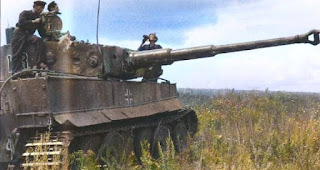 |
| German infantry in the Ukrainian steppe |
Nazi dictator Adolf Hitler reluctantly agreed on Sept. 15 1943 to allow Gen.Feldm. Erich von Manstein to pull his troops back behind the Dnieper. The Das Reich, Totenkopf and Wiking Divisions were now operating under the command of the German 8th Army during the withdrawal back to the Dnieper at Kremenchug. The three once-proud SS-Panzergrenadier divisions were now badly weakened by almost three month of constant combat. Fortifications were erected along the length of the Dnieper. However, there was no hope of completing an extensive defensive line in the short time available. Instead, they were concentrated in areas where a Soviet assault-crossing were most likely to be attempted. Additionally, on Sept. 7 1943, the Wehrmacht and the Waffen-SS received orders to implement a scorched-earth policy, by stripping the areas they had to abandon of anything that could be used by the Soviet war effort. Whilst the scorched-earth policy ordered by Hitler in 1943 is widely-known, less known is that the Soviet dictator Josef Stalin announced a scorched-earth policy from the initial days of the Barbarossa in 1941. This policy adopted by the retreating Soviets resulted in untold misery and death for a large but unknown numbers of Soviet civilians. Notable historic examples of scorched-earth tactics include the Russian army's strategy during the Swedish invasion of Russia in 1708, the Napoleonic invasion of Russia in 1812 and the initial Soviet retreat during the German invasion of the Soviet Union in 1941. Top image: a Tiger tank crew taking a break while the tanker in the top turret stares straight ahead on the exposed eastern steppe. c. Bundesarchiv. Middle image: German infantry crossing a Ukrainian village in flames. Photo by the well-known Kriegsberichter Feldwebel Arthur Grimm. Credit: Facundo Filipe. Originally published in the Nazi-era propaganda magazine Signal. It was published fortnightly in as many as 25 editions and 30 languages. Bottom clip: Eastern Front's southern section in the fall of 1943. Die Deutsche Wochenschau.


I know the aimer, He told this was at battle of Kursk, he destroyed 36 T34's on this battle he was only 16 years on this picture. His friend next to him told he had to wear his helmet, why is he wearing no helmet? Well you cant aim with a helmet on. 5 days after this picture was made his friend died (the one with the helmet). RIP
ReplyDeleteArmy Group South was subsequently forced to abandon much of southern Ukraine in a race for the safety of the Dnieper. Despite the remarkable efforts of the German Army and Waffen SS panzer divisions during July and August, the Germans were too weak to hold the Kharkov-Belgorod-Poltava sector after their summer losses. This thread provides a great month-by-month summary of the bitter battles in the Southern Sector of the Eastern Front during the second half of 1943. Amazing website! Mindaugas V.
ReplyDelete